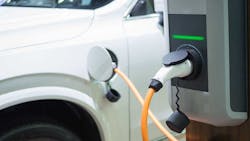EV Charging Station Innovations Boost Efficiency and Speed (.PDF Download)
The proliferation of electric vehicles is driving the need for a charging infrastructure, and it must include electric-vehicle supply equipment (EVSE) that’s both energy-efficient and fast. Although overnight charging may be acceptable for some commuters, most drivers will demand the flexibility that comes from half-hour charging operations.
Charging systems come in two basic types—ac and dc—and three levels (L1, L2, and L3). An ac charger supplies ac voltage to an EV’s onboard charger (OBC), which incorporates an ac-dc converter as shown in Figure 1. An L1 ac implementation operates at 120 or 230 V ac (single phase) and can charge a 24-kWh battery in approximately 17 hours. An L2 implementation operates at 208 to 240 V ac (single/split phase) and can charge the same battery in approximately eight hours.
